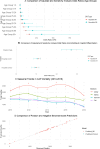Host and environmental determinants of in-hospital mortality in community-acquired pneumonia: evidence of seasonality, socioeconomic factors, and hospital differentiation in Portugal
- PMID: 40462005
- PMCID: PMC12131333
- DOI: 10.1186/s12890-025-03716-8
Host and environmental determinants of in-hospital mortality in community-acquired pneumonia: evidence of seasonality, socioeconomic factors, and hospital differentiation in Portugal
Abstract
Background: Community-Acquired Pneumonia (CAP) is regarded as a substantial part of the global burden of disease and a public health priority. In addition to host factors, such as demographic characteristics, comorbidities, CAP clinical severity, and in-hospital mortality may also be influenced by factors such as socioeconomic status, seasonal variations, and hospital differentiation. This study aims to analyse trends in hospital mortality among patients hospitalized with CAP in National Health Service (NHS) hospitals in mainland Portugal and the impact of various host and environmental factors on in-hospital mortality. METHODS: This retrospective cross-sectional study analyzed 378,449 hospitalization episodes with CAP as the primary diagnosis (ICD-9-CM and ICD-10-CM/PCS) in mainland Portugal from 2010 to 2018. Data were sourced from the National Hospital Discharge Database and population census records. Variables included host factors (demographic characteristics, secondary diagnoses, CAP clinical severity indicators, Charlson score) as well as environmental factors, such as seasonality, socioeconomic factors and hospital differentiation. Trend analysis of hospitalization episodes and in-hospital mortality due to CAP was performed. Multivariable logistic regression was used to examine associations with in-hospital mortality, with statistical significance set at p < 0.05.
Results: A decrease in the number of hospitalization episodes and in-hospital mortality rate over time was observed. The regression model identified advanced age, male gender, secondary diagnoses, CAP clinical severity, high Charlson score, the summer season, early school leaving rate, higher unemployment rate, and lower hospital differentiation as factors associated with an increased probability of death (p < 0.001). CONCLUSIONS: Throughout the nine-year period, a steady decline in in-hospital mortality rates was observed. In-hospital mortality exhibited a dual influence, shaped by host factors (such as age, gender, secondary diagnoses, CAP clinical severity, Charlson score) and environmental factors, including the summer season, socioeconomic vulnerability and hospital capabilities. Therefore, effectively reducing CAP in-hospital mortality requires comprehensive policies that focus on at-risk groups and address a broad range of both host and environmental risk factors. These policies should aim to improve healthcare access, increase vaccination coverage, and enhance thermal housing conditions, with particular attention to socially vulnerable individuals.
Keywords: Age factors; Community-Acquired Pneumonia; Comorbidity; Gender; Hospital mortality; Low socioeconomic status; Risk factors; Weather.
© 2025. The Author(s).
Conflict of interest statement
Declarations. Ethics approval and consent to participate: The Ethics Committee of the Lisbon Faculty of Medicine approved the study (No: 15/23). This study was conducted in accordance with the principles of the Declaration of Helsinki. The subjects’ anonymity was maintained; therefore, informed consent was not required. Consent for publication: Not applicable. Competing interests: The authors declare no competing interests.
Figures




References
-
- GBD 2016 Lower Respiratory Infections Collaborators. Estimates of the global, regional, and national morbidity, mortality, and aetiologies of lower respiratory infections in 195 countries, 1990–2016: a systematic analysis for the Global Burden of Disease Study 2016. Lancet Infect Dis. 2018;18(11):1191–1210. 10.1016/S1473-3099(18)30310-4. Epub 2018 Sep 19. PMID: 30243584; PMCID: PMC6202443. - PMC - PubMed
-
- Torres A, Cilloniz C, Niederman MS, Menéndez R, Chalmers JD, Wunderink RG, van der Poll T. Pneumonia Nat Rev Dis Primers. 2021;7(1):25. 10.1038/s41572-021-00259-0. (PMID: 33833230). - PubMed
-
- Torres A, Cillóniz C, Blasi F, Chalmers JD, Gaillat J, Dartois N, Schmitt HJ, Welte T. Burden of pneumococcal community-acquired pneumonia in adults across Europe: A literature review. Respir Med. 2018;137:6–13. 10.1016/j.rmed.2018.02.007. (Epub 2018 Feb 19 PMID: 29605214). - PubMed
MeSH terms
Grants and funding
LinkOut - more resources
Full Text Sources
Medical
Miscellaneous

